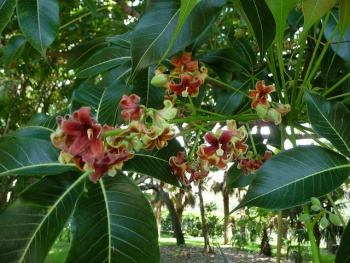Difference between revisions of "Sterculia Foetida"
From Wikiwel
(→Benefits and uses of Sterculia Foetida are) |
|||
| (2 intermediate revisions by the same user not shown) | |||
| Line 1: | Line 1: | ||
| − | Other Names : Sterculia foetida, Stinky sterculia, Wild Indian Almond, Peon, Poon Tree, Hazel Sterculia, Java Olive, Skunk Tree, Jungli Badam; Kudrapdukku, Pinari, Kokaru, Kukar, Goldhar. | + | [[File:Sterculic.jpg|thumb|350px|left|Sterculia Foetida]] |
| + | Other Names : Sterculia foetida, Stinky sterculia, Wild Indian Almond, wild almond, Peon, Poon Tree, bastard poon tree, Hazel Sterculia, Java Olive, Skunk Tree, Jungli Badam; Kudrapdukku, Pinari, Kokaru, Kukar, Goldhar.<br>A soft wooded tree that can grow up to 115 feet tall. It was described in 1753 by Carolus Linnaeus. The origin of the name of the bad-smelling Sterculia genus comes from the Roman god, Sterquilinus, who was the god of ferilizer or manure. | ||
==Special Precautions of Sterculia Foetida== | ==Special Precautions of Sterculia Foetida== | ||
==Benefits and uses of Sterculia Foetida are== | ==Benefits and uses of Sterculia Foetida are== | ||
| Line 5: | Line 6: | ||
* Obesity : a study published in the journal Obesity in 2013 found that obese rats fed a sterculic-oil-enriched diet for ten weeks experienced improvements in metabolic health. Study results showed that treatment with sterculic oil led to a decrease in SCD1 activity, which appeared to help regulate blood sugar, reduce abdominal fat, and lower cholesterol levels. | * Obesity : a study published in the journal Obesity in 2013 found that obese rats fed a sterculic-oil-enriched diet for ten weeks experienced improvements in metabolic health. Study results showed that treatment with sterculic oil led to a decrease in SCD1 activity, which appeared to help regulate blood sugar, reduce abdominal fat, and lower cholesterol levels. | ||
* Diabetes : a study published in ISRN Endocrinology in 2012 found that mice given sterculic oil for nine weeks had a decrease in liver inflammation and an improvement in insulin tolerance (a key marker of metabolic health). | * Diabetes : a study published in ISRN Endocrinology in 2012 found that mice given sterculic oil for nine weeks had a decrease in liver inflammation and an improvement in insulin tolerance (a key marker of metabolic health). | ||
| + | *a study published in ISRN Endocrinology in 2012 found that mice given sterculic oil for nine weeks had a decrease in liver inflammation and an improvement in insulin tolerance (a key marker of metabolic health). | ||
[[Category:Treatments]] | [[Category:Treatments]] | ||
[[Category:herbal medicine]] | [[Category:herbal medicine]] | ||
Latest revision as of 02:02, 21 June 2014
Other Names : Sterculia foetida, Stinky sterculia, Wild Indian Almond, wild almond, Peon, Poon Tree, bastard poon tree, Hazel Sterculia, Java Olive, Skunk Tree, Jungli Badam; Kudrapdukku, Pinari, Kokaru, Kukar, Goldhar.
A soft wooded tree that can grow up to 115 feet tall. It was described in 1753 by Carolus Linnaeus. The origin of the name of the bad-smelling Sterculia genus comes from the Roman god, Sterquilinus, who was the god of ferilizer or manure.
Special Precautions of Sterculia Foetida
Benefits and uses of Sterculia Foetida are
Sterculic oil may aid in the treatment of certain Metabolic disorders :
- Obesity : a study published in the journal Obesity in 2013 found that obese rats fed a sterculic-oil-enriched diet for ten weeks experienced improvements in metabolic health. Study results showed that treatment with sterculic oil led to a decrease in SCD1 activity, which appeared to help regulate blood sugar, reduce abdominal fat, and lower cholesterol levels.
- Diabetes : a study published in ISRN Endocrinology in 2012 found that mice given sterculic oil for nine weeks had a decrease in liver inflammation and an improvement in insulin tolerance (a key marker of metabolic health).
- a study published in ISRN Endocrinology in 2012 found that mice given sterculic oil for nine weeks had a decrease in liver inflammation and an improvement in insulin tolerance (a key marker of metabolic health).
